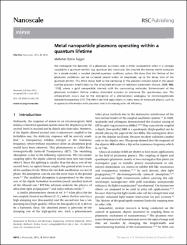| dc.description.abstract | We investigate the dynamics of a plasmonic oscillation over a metal nanoparticle when it is strongly coupled to a quantum emitter (e.g. quantum dot, molecule). We simulate the density matrix evolution for a simple model, a coupled classical–quantum oscillators system. We show that the lifetime of the plasmonic oscillations can be increased several orders of magnitude, up to the decay time of the quantum emitter. This effect shows itself as the narrowing of the plasmon emission band in the spaser (surface plasmon amplification by the stimulated emission of radiation) experiment [Nature, 2009, 460, 1110], where a gold nanoparticle interacts with the surrounding molecules. Enhancement of the plasmonic excitation lifetime enables stimulated emission to overcome the spontaneous one. The enhancement occurs due to the emergence of a phenomenon analogous to electromagnetically induced transparency (EIT). The effect can find applications in many areas of nanoscale physics, such as in quantum information with plasmons and in increasing solar cell efficiency. | |



















